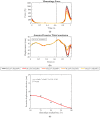Walking with a Posterior Cruciate Ligament Injury: A Musculoskeletal Model Study
- PMID: 37892908
- PMCID: PMC10604140
- DOI: 10.3390/bioengineering10101178
Walking with a Posterior Cruciate Ligament Injury: A Musculoskeletal Model Study
Abstract
The understanding of the changes induced in the knee's kinematics by a Posterior Cruciate Ligament (PCL) injury is still rather incomplete. This computational study aimed to analyze how the internal loads are redistributed among the remaining ligaments when the PCL is lesioned at different degrees and to understand if there is a possibility to compensate for a PCL lesion by changing the hamstring's contraction in the second half of the swing phase. A musculoskeletal model of the knee joint was used for simulating a progressive PCL injury by gradually reducing the ligament stiffness. Then, in the model with a PCL residual stiffness at 15%, further dynamic simulations of walking were performed by progressively reducing the hamstring's force. In each condition, the ligaments tension, contact force and knee kinematics were analyzed. In the simulated PCL-injured knee, the Medial Collateral Ligament (MCL) became the main passive stabilizer of the tibial posterior translation, with synergistic recruitment of the Lateral Collateral Ligament. This resulted in an enhancement of the tibial-femoral contact force with respect to the intact knee. The reduction in the hamstring's force limited the tibial posterior sliding and, consequently, the tension of the ligaments compensating for PCL injury decreased, as did the tibiofemoral contact force. This study does not pretend to represent any specific population, since our musculoskeletal model represents a single subject. However, the implemented model could allow the non-invasive estimation of load redistribution in cases of PCL injury. Understanding the changes in the knee joint biomechanics could help clinicians to restore patients' joint stability and prevent joint degeneration.
Keywords: PCL injury; knee joint biomechanics; knee ligaments; musculoskeletal modeling.
Conflict of interest statement
The authors declare no conflict of interest.
Figures












